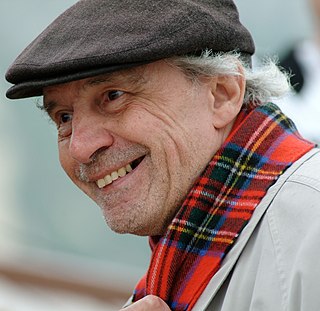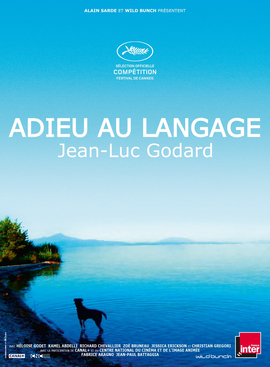
Cahiers du Cinéma is a French film magazine co-founded in 1951 by André Bazin, Jacques Doniol-Valcroze, and Joseph-Marie Lo Duca. It developed from the earlier magazine Revue du Cinéma involving members of two Paris film clubs—Objectif 49 and Ciné-Club du Quartier Latin.
Andrew Sarris was an American film critic. He was a leading proponent of the auteur theory of film criticism.

Jean-Luc Godard was a French and Swiss film director, screenwriter, and film critic. He rose to prominence as a pioneer of the French New Wave film movement of the 1960s, alongside such filmmakers as François Truffaut, Agnès Varda, Éric Rohmer and Jacques Demy. He was arguably the most influential French filmmaker of the post-war era. According to AllMovie, his work "revolutionized the motion picture form" through its experimentation with narrative, continuity, sound, and camerawork. His most acclaimed films include Breathless (1960), Vivre sa vie (1962), Contempt (1963), Band of Outsiders (1964), Alphaville (1965), Pierrot le Fou (1965), Masculin Féminin (1966), Weekend (1967) and Goodbye to Language (2014).
David Holzman's Diary is a 1967 American mockumentary, or work of metacinema, directed by James McBride and starring L. M. Kit Carson. A feature-length film made on a tiny budget over several days, it is a work of experimental fiction presented as an autobiographical documentary. "A self-portrait by a fictional character in a real place—New York's Upper West Side," the film comments on the title character's personality and life as well as on documentary filmmaking and the medium of cinema more generally. In 1991, David Holzman's Diary was included in the annual selection of 25 motion pictures added to the National Film Registry of the Library of Congress, being deemed "culturally, historically, or aesthetically significant" and recommended for preservation.
Marcel Ophuls is a German-French documentary film maker and former actor, best known for his films The Sorrow and the Pity and Hôtel Terminus: The Life and Times of Klaus Barbie.

Jacques Rivette was a French film director and film critic most commonly associated with the French New Wave and the film magazine Cahiers du Cinéma. He made twenty-nine films, including L'Amour fou (1969), Out 1 (1971), Celine and Julie Go Boating (1974), and La Belle Noiseuse (1991). His work is noted for its improvisation, loose narratives, and lengthy running times.

Anne Wiazemsky was a French actress and novelist. She made her cinema debut at the age of 18, playing Marie, the lead character in Robert Bresson's Au hasard Balthazar (1966). A year later she married the director Jean-Luc Godard and appeared in several of his films, including La Chinoise (1967), Week End (1967), and One Plus One (1968).

Jonathan Rosenbaum is an American film critic and author. Rosenbaum was the head film critic for The Chicago Reader from 1987 to 2008, when he retired. He has published and edited numerous books about cinema and has contributed to such notable film publications as Cahiers du cinéma and Film Comment.
Jean-Marie Straub and Danièle Huillet were a duo of French filmmakers who made two dozen films between 1963 and 2006. Their films are noted for their rigorous, intellectually stimulating style and radical, communist politics. While both were French, they worked mostly in Germany and Italy. From the Clouds to the Resistance (1979) and Sicilia! (1999) are among the duo's best regarded works.

A Married Woman is a 1964 French drama film directed by Jean-Luc Godard, his eighth feature film.

Mark Rappaport is an American independent/underground film director and film critic, who has been working since the 1960s.

In Praise of Love is a 2001 French film written and directed by Jean-Luc Godard. The black-and-white and color drama was shot by Julien Hirsch and Christophe Pollock. Godard has famously stated that "a film should have a beginning, a middle and an end, but not necessarily in that order." This aphorism is illustrated by In Praise of Love, which reverses the order of past and present. It was selected as the Swiss entry for the Best Foreign Language Film at the 74th Academy Awards, but it was not nominated.
Adrian Martin is an Australian film and arts critic. He now lives in Malgrat de Mar in Spain. He is Adjunct Associate Professor in Film Culture and Theory at Monash University. His work has appeared in many magazines, journals and newspapers around the world, and has been translated into over twenty languages and has regular columns in the Dutch De Filmkrant and in Caiman: Cuadernos de cine.

Hail Mary is a 1985 French avant-garde erotic drama film written and directed by Jean-Luc Godard. The film is a modern retelling of the story of the virgin birth of Jesus. It was entered into the 35th Berlin International Film Festival.

Histoire(s) du cinéma is an eight-part video project begun by Jean-Luc Godard in the late 1980s and completed in 1998. The longest, at 266 minutes, and one of the most complex of Godard's films, Histoire(s) du cinéma is an examination of the history of the concept of cinema and how it relates to the 20th century; in this sense, it can also be considered a critique of the 20th century and how it perceives itself. The project is widely considered Godard's magnum opus.
Rob Tregenza is a North American cinematographer, film director, and producer who has worked as a director of photography with Béla Tarr, Claude Miller, Pierre William Glenn, and Alex Cox.

Housekeeping is a 1987 American comedy-drama film written and directed by Bill Forsyth, starring Christine Lahti, Sara Walker, and Andrea Burchill. Based on Marilynne Robinson's 1980 novel Housekeeping, it is about two young sisters growing up in Idaho in the 1950s. After being abandoned by their mother and raised by elderly relatives, the sisters are looked after by their eccentric aunt whose unconventional and unpredictable ways affect their lives. It was filmed on location in Alberta and British Columbia, Canada. It won two awards at the 1987 Tokyo International Film Festival.

Goodbye to Language is a 2014 French-Swiss narrative essay film written and directed by Jean-Luc Godard. It stars Héloïse Godet, Kamel Abdeli, Richard Chevallier, Zoé Bruneau, Jessica Erickson and Christian Grégori and was shot by cinematographer Fabrice Aragno. It is Godard's 42nd feature film and 121st film or video project. In the French-speaking parts of Switzerland where it was shot, the word "adieu" can mean both goodbye and hello. The film depicts a couple having an affair. The woman's husband discovers the affair and the lover is killed. Two pairs of actors portray the couple and their actions repeat and mirror one another. Godard's own dog Roxy Miéville has a prominent role in the film and won a prize at the Cannes Film Festival. Like many of Godard's films, it includes numerous quotes and references to previous artistic, philosophical and scientific works, most prominently those of Jacques Ellul, Aleksandr Solzhenitsyn and Mary Shelley.

Jacques Rivette was a French film director and film critic most commonly associated with the French New Wave and the film magazine Cahiers du Cinéma. He made twenty-nine films, including L'amour fou (1969), Out 1 (1971), Celine and Julie Go Boating (1974), and La Belle Noiseuse (1991). His work is noted for its improvisation, loose narratives, and lengthy running times.

The Image Book is a 2018 Swiss avant-garde essay film directed by Jean-Luc Godard. Initially titled Tentative de bleu and Image et parole, in December 2016 Wild Bunch co-chief Vincent Maraval stated that Godard had been shooting the film for almost two years "in various Arab countries, including Tunisia" and that it is an examination of the modern Arabic world. Godard told Séance magazine that he was shooting without actors but the film would have a storyteller. It was selected to compete for the Palme d'Or at the 2018 Cannes Film Festival. The film was positively received by film critics. It was the final film directed by Godard before his death in 2022.














